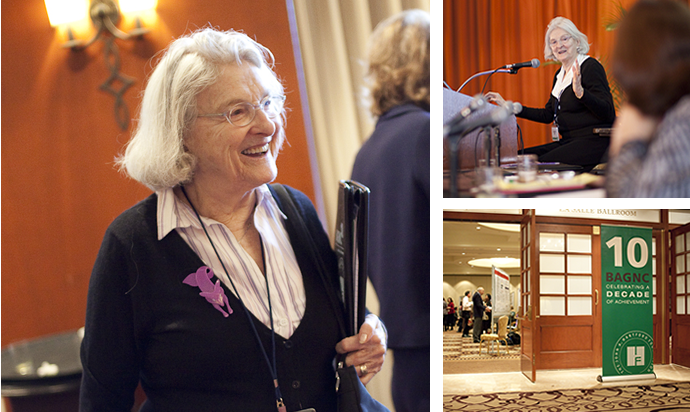Claire M. Fagin, PhD, RN
Exemplifying a Passion for Geriatric Nursing
Hartford Foundation investments in expanding the role of geriatric nursing have paid off handsomely in large measure because of the leadership of Dr. Fagin, nurse, educator, academic, and consultant. Dr. Fagin served as Dean of the School of Nursing at the University of Pennsylvania from 1977 to 1992, and Presidential Chair at the University of California, San Francisco, in early 1993. Later that year, she was named Interim President of the University of Pennsylvania, becoming the first woman university president at an Ivy League school.
Shortly after her retirement from the University of Pennsylvania, from 2000 to 2005, she served as director of the Foundation’s Building Academic Geriatric Nursing Capacity (BAGNC) Initiative, which she helped conceive, design, and implement. She remembers working closely with Foundation staff to come up with the idea and fine-tune it.

(Above) Claire M. Fagin, PhD, RN, addressing the 2010 BAGNC Leadership Conference in New Orleans, LA. Here she shares lessons on leadership from her life to Hartford nursing students and faculty.
The plan called for developing a scholars program and establishing academic centers of geriatric nursing excellence. To create the centers, letters were sent to 11 schools, and from the respondents, five were chosen that had an established “critical mass of geriatric nursing.” The program proved successful, and still working with the Foundation, she helped establish an “investment program,” supporting schools that demonstrated gero strength. “They turned out to be good investments,” she says.
As BAGNC’s director, Dr. Fagin continued to build the program, monitoring its operation and progress and mentoring its directors. When she turned the program over to Patricia G. Archbold, DNSc, RN, in 2005, Dr. Fagin continued working with her as a consultant, and she’s been closely involved with other Hartford staff over the years. “I feel intimately involved with the Foundation, even though my formal relationship with them ended some time ago,” she says. “And I still feel they are the only ones doing what they do, and the only people we can look to for building what is needed in this terribly important field of geriatrics.”